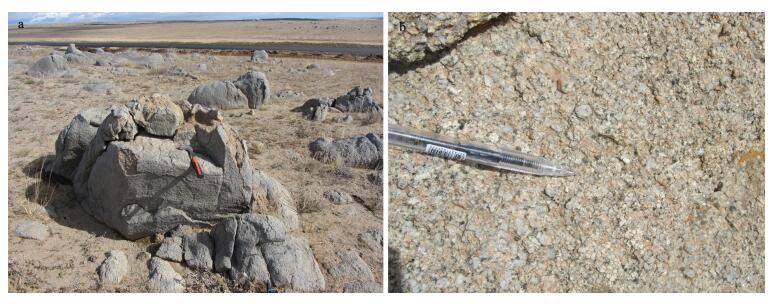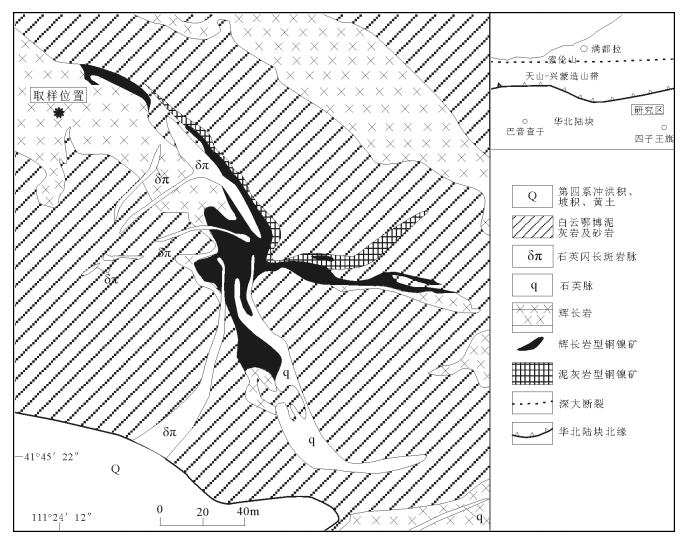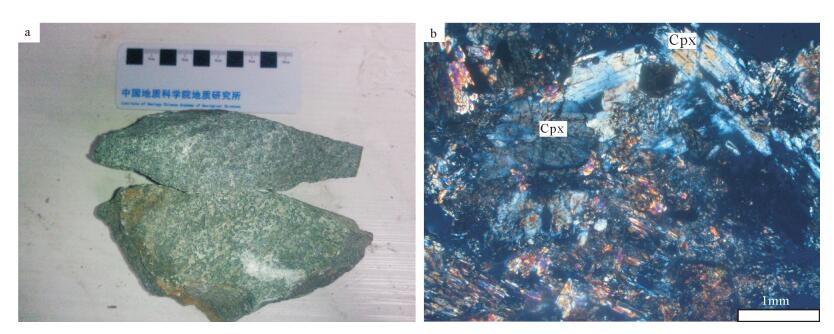LA-ICP-MS zircon U-Pb dating of the gabbro from Xiaonanshan, Siziwang Banner, Inner Mongolia, and its geological significance
-
摘要:
四子王旗地区小南山为内蒙古中部镁铁质-超镁铁质岩带内发育的一个中型铜镍铂硫化物矿床, 辉长岩为含矿岩体的成矿母岩。岩石主量、微量及稀土元素分析结果表明, 小南山辉长岩属于铁质镁铁质岩, 具有拉斑玄武岩系列演化趋势, 相对富集大离子亲石元素(Rb、Ba、U、Pb等)和亏损高场强元素(Nb、Ta、Ti), 并具有轻、重稀土元素分馏相对明显、轻稀土元素相对富集、重稀土元素亏损的右倾型稀土元素配分模式。采用LA-ICP-MS锆石U-Pb测年法, 获得小南山辉长岩年龄结果为272.7±2.9Ma, 代表了小南山辉长岩体的成岩成矿时代, 属中二叠世。区域地质资料及微量元素特征表明, 小南山岩体可能形成于板内构造环境
-
关键词:
- 四子王旗 /
- 小南山辉长岩 /
- 中二叠世 /
- 板内 /
- LA-ICP-MS锆石U-Pb年龄
Abstract:Located on the northwestern margin of the North China Craton, Siziwang Banner belongs tectonically to Bayun Obo mar-ginal rift. It is about 100km away from the north of Solonker suture. A mafic-ultramafic belt is exposed in central Inner Mongolia, in EW extension roughly 300km long and 30km wide, comprising a favorable metallogenic belt for Cu-Ni (PGE) sulfide deposits. Many Cu-Ni (PGE) deposits (ore spots) have been found here including the Xiaonanshan Cu-Ni (PGE) deposit. The Xiaonanshan intrusion consists of gabbro and belongs to the tholetiitic series in petrochemical composition. Most of the rocks are relatively en-riched in large ion lithophile elements (Rb, Ba, U, Pb) and depleted in high field strength elements (Nb, Ta, Ti), exhibiting right-in-clined linear REE patterns with LREE enrichment relative to HREE. LA-ICP-MS U-Pb dating of zircons from Xiaonanshan orebearing gabbro yielded an age of 272.7±2.9Ma, indicating that the pluton should be the Mid-Permain intrusion. According to the re-gional geology, combined with the geochemical features, it may be inferred that the intrusion may be associated with intraplate tec-tonic setting
-
蒙古戈壁阿尔泰省与中国新疆自治区隔国界相望,大地构造位置属于南戈壁-阿尔泰构造带[1-4],毗邻准噶尔弧盆系东缘,由一系列岛弧和增生杂岩带组成。区内广泛发育中酸性侵入岩,多呈深成相的岩基或中小型岩株产出,与准噶尔地区广泛分布的晚古生代侵入岩交相呼应。依据前人获得的大量锆石年代学数据[5-9],准噶尔地区深成岩浆活动集中分布在早石炭世—早二叠世,在晚石炭世末达到高峰,形成古洋盆、洋岛、岛弧、后碰撞等不同构造环境下复杂的岩浆体系[5, 10-12]。在此背景下,同样集中发育晚古生代深成岩的南戈壁-阿尔泰构造带,与准噶尔弧盆系岩浆演化的关联和对比缺乏相关岩体年龄的报道,这也是笔者关注的焦点。本次选择南戈壁-阿尔泰构造带巴音陶勒盖一带的二长花岗岩为研究对象,采用LA-ICP-MS测年技术,获得其锆石U-Pb年龄为300.2±0.9Ma,为区域构造-岩浆活动提供了可靠的年代学数据,同时为约束南戈壁-阿尔泰构造带华力西期造山运动时限提供了新证据。
1. 地质背景及岩石特征
南戈壁-阿尔泰构造带邻近准噶尔弧盆系(图 1-a),由次级构造单元Transaltay晚古生代岛弧和Nemegt古生代增生楔构成。研究区位于Transaltay岛弧带南缘巴音陶勒盖一带,地理位置属于蒙古戈壁阿尔泰省南部边境地区。区域构造以断裂为主,北西—南东向断裂十分发育,被数条北东—南西向断裂切割,共同组成了区内断块镶嵌的构造环境。区域地层出露下泥盆统Ulgii组(D1ul)、下石炭统Noyonuul组(C1nn)、Sayriinshand组(C1sr)、上白垩统(未分)(K2)、渐新统(未分)(E3)及上新统(未分)(N2),部分被第四系盖层覆盖(图 1-b)。Ulgii组分为上、下两段,上段为巨厚的玄武岩、安山岩、集块凝灰岩、凝灰质砾岩建造,局部可见流纹岩层、砂岩及硅化粉砂岩夹层,下段为碳酸盐岩、酸性凝灰岩建造,夹绿片岩及破碎的硅化灰岩层,主要出露在研究区中部与西南部,与其上的Noyonuul组不整合接触,后者为一套安山岩、玄武岩、凝灰岩、凝灰质砂岩及凝灰质粉砂岩建造,厚约1500m,在区内广泛分布。Sayriinshand组主要为一套未分异的火山岩系,仅出露在研究区东南部,建造组成有安山岩-英安岩、流纹岩-粗面岩、凝灰岩及熔结凝灰岩、凝灰质砂岩、杂砂质砾岩、粉砂岩及泥页岩,夹薄层状灰岩透镜体,与其上的中新生界不整合接触。
![]() Qph—更新统-全新统;Qp—更新统;N2—上新统;E3—渐新统;K2—上白垩统;C1nn—Noyonuul组;D1ul—Ulgii组;1—花岗岩;2—花岗闪长岩;3—闪长岩;4—辉长岩;5—正长花岗岩;6—二长花岗岩;7—断裂;8—整合界线;9—不整合界线;10—采样位置。Ⅰ-3-1—萨吾尔-二台-Hrairhan弧盆带;Ⅰ-3-2—洪古勒楞-阿尔曼太-Baitag弧盆带;Ⅰ-3-3—谢米斯台-库兰喀孜干弧盆带;Ⅰ-3-4—三塘湖弧盆带;Ⅰ-3-5—唐巴勒-喀拉麦里缝合带;Ⅰ-5-1—南戈壁-阿尔泰构造带Figure 1. Tectonic sketch map (a)and geological map (b)of Bayintolgoi, Mongolia
Qph—更新统-全新统;Qp—更新统;N2—上新统;E3—渐新统;K2—上白垩统;C1nn—Noyonuul组;D1ul—Ulgii组;1—花岗岩;2—花岗闪长岩;3—闪长岩;4—辉长岩;5—正长花岗岩;6—二长花岗岩;7—断裂;8—整合界线;9—不整合界线;10—采样位置。Ⅰ-3-1—萨吾尔-二台-Hrairhan弧盆带;Ⅰ-3-2—洪古勒楞-阿尔曼太-Baitag弧盆带;Ⅰ-3-3—谢米斯台-库兰喀孜干弧盆带;Ⅰ-3-4—三塘湖弧盆带;Ⅰ-3-5—唐巴勒-喀拉麦里缝合带;Ⅰ-5-1—南戈壁-阿尔泰构造带Figure 1. Tectonic sketch map (a)and geological map (b)of Bayintolgoi, Mongolia此外,研究区沿断裂带两侧发育大面积分布的中酸性侵入岩体,岩性为花岗岩、花岗闪长岩、二长花岗岩、正长花岗岩、闪长岩及少量辉长岩,主要分布在研究区中部与南部地区,与周围地层多呈侵位或断层接触关系。本次选择风化程度较低、新鲜的二长花岗岩作为研究对象,样品(MND202)采自阿尔泰省巴音陶勒盖西南16km处(图 2),坐标位置N44°51′20″、E96°56′09″(图 1)。二长花岗岩风化面呈黄褐色,新鲜面为灰白色、浅肉红色,中粗粒花岗结构,块状构造。矿物成分为:钾长石,呈灰白色、浅肉红色,半自形板柱状,大小1~8mm,含量30%~35%;斜长石,呈灰白色,自形-半自形柱状或板状,聚片双晶发育,大小0.5~6mm,含量25%~30%;石英,为白色透明,他形粒状,大小2~8mm,含量30%~35%;少量暗色矿物黑云母、角闪石,含量小于5%;球形风化较弱,无矿化蚀变。
2. 分析方法
测试样品在河北省廊坊区域地质调查研究所制备。锆石分选方法为浮选和电磁选,在双目镜下挑选出晶形和透明度较好的锆石颗粒,将其粘贴在环氧树脂表面,打磨抛光后制成样靶,并进行透射光、反射光和阴极发光显微观察及照相。
LA-ICP-MS锆石U-Pb同位素测试在天津地质调查中心同位素实验室完成。实验仪器为激光剥蚀多接收器电感耦合等离子体质谱仪,包括Thermo Fisher公司生产的Neptune多接收器电感耦合等离子质谱和ESI公司生产的NEW WAVE193nm FX ArF准分子激光器。实验过程使用193nm激光器对锆石进行剥蚀及U-Pb同位素原位测定,激光剥蚀斑束直径为35μm,采用标准锆石GJ-1作为外标进行同位素分馏校正,数据及图件处理利用ICP-MS DataCal程序[13]和Isoplot程序[14]完成。普通铅据208Pb进行校正,利用NIST SRM610玻璃标样作为外标计算锆石样品中的U、Pb含量。测试结果见表 1。
表 1 蒙古巴音陶勒盖二长花岗岩LA-ICP-MS锆石U-Th-Pb同位素分析结果Table 1. LA-ICP-MS U-Th-Pb isotopic data of zircons from the monzogranite sample in Bayintolgoi, Mongolia测点 Pb/10-6 U/10-6 Th/U 206Pb/238U 207Pb/235U 207Pb/206Pb 206Pb/238U 207Pb/235U 207Pb/206Pb 比值 1σ 比值 1σ 比值 1σ 年龄/Ma 1σ 年龄/Ma 1σ 年龄/Ma 1σ MND202-1 25 443 1.060 0.04757 0.00035 0.3359 0.0054 0.05122 0.00079 300 2 294 5 251 35 MND202-2 18 306 1.347 0.04776 0.00035 0.3561 0.0082 0.05406 0.00119 301 2 309 7 374 49 MND202-3 14 244 1.436 0.04738 0.00037 0.3396 0.0088 0.05199 0.00133 298 2 297 8 285 58 MND202-4 37 688 1.065 0.04714 0.00031 0.3408 0.0040 0.05244 0.00060 297 2 298 3 304 26 MND202-5 29 529 1.098 0.04572 0.00029 0.3933 0.0074 0.06238 0.00115 288 2 337 6 687 39 MND202-6 17 274 1.800 0.04756 0.00032 0.4313 0.0117 0.06577 0.00176 300 2 364 10 799 56 MND202-7 37 672 1.103 0.04862 0.00031 0.3523 0.0037 0.05255 0.00055 306 2 306 3 310 24 MND202-8 40 791 0.779 0.04613 0.00029 0.3410 0.0047 0.05361 0.00072 291 2 298 4 355 30 MND202-9 18 286 1.678 0.04785 0.00032 0.3664 0.0093 0.05553 0.00138 301 2 317 8 434 55 MND202-10 64 1175 0.962 0.04784 0.00031 0.3683 0.0035 0.05583 0.00051 301 2 318 3 446 20 MND202-11 34 626 0.852 0.04768 0.00031 0.3551 0.0045 0.05403 0.00066 300 2 309 4 372 27 MND202-12 25 469 0.883 0.04760 0.00031 0.3406 0.0053 0.05189 0.00078 300 2 298 5 280 35 MND202-13 39 703 1.084 0.04745 0.00031 0.3688 0.0044 0.05637 0.00064 299 2 319 4 467 25 MND202-14 51 943 1.028 0.04451 0.00028 0.5130 0.0089 0.08358 0.00138 281 2 420 7 1283 32 MND202-15 32 622 0.733 0.04742 0.00032 0.3334 0.0049 0.05100 0.00071 299 2 292 4 241 32 MND202-16 34 672 0.654 0.04749 0.00031 0.3341 0.0044 0.05103 0.00066 299 2 293 4 242 30 MND202-17 39 701 1.120 0.04789 0.00038 0.3488 0.0044 0.05282 0.00062 302 2 304 4 321 27 MND202-18 16 289 1.096 0.04804 0.00036 0.3450 0.0089 0.05209 0.00132 302 2 301 8 289 58 MND202-19 42 947 0.063 0.04786 0.00037 0.3526 0.0038 0.05344 0.00050 301 2 307 3 347 21 MND202-20 37 706 0.845 0.04787 0.00036 0.3432 0.0045 0.05201 0.00060 301 2 300 4 286 27 MND202-21 14 263 0.803 0.04789 0.00039 0.3531 0.0099 0.05347 0.00149 302 2 307 9 349 63 MND202-22 38 643 1.289 0.04802 0.00037 0.3484 0.0045 0.05262 0.00064 302 2 304 4 312 28 MND202-23 19 337 1.105 0.04785 0.00034 0.3645 0.0069 0.05525 0.00104 301 2 316 6 422 42 MND202-24 17 309 0.859 0.04805 0.00035 0.3234 0.0075 0.04881 0.00111 303 2 285 7 139 53 MND202-25 12 202 1.193 0.04693 0.00032 0.3455 0.0116 0.05339 0.00175 296 2 301 10 346 74 MND202-26 41 818 0.879 0.04389 0.00028 0.3536 0.0084 0.05842 0.00137 277 2 307 7 546 51 MND202-27 9 161 1.257 0.04711 0.00033 0.3511 0.0138 0.05406 0.00205 297 2 306 12 373 85 MND202-28 41 811 0.966 0.04422 0.00030 0.3543 0.0056 0.05812 0.00082 279 2 308 5 534 31 MND202-29 24 454 0.936 0.04735 0.00039 0.3476 0.0062 0.05324 0.00086 298 2 303 5 339 37 MND202-30 47 845 1.077 0.04768 0.00034 0.3853 0.0046 0.05862 0.00062 300 2 331 4 553 23 3. 分析结果
3.1 锆石CL特征
通过阴极发光(CL)图像(图 3)观察,锆石表面较干净,粒径大小90~200μm,多呈长柱状、短柱状、不规则次棱角状,自形-半自形发育。CL图像显示,锆石颗粒多具有明显的初始岩浆特征的振荡环带,部分存在核-边结构,个别锆石的边部环带弱化,有热液蚀变迹象。测定的锆石中,除1粒锆石外,其余锆石Th/U值介于0.65~1.79之间,远高于临界值0.1或0.4[15-17],热液活动未破坏锆石U-Pb体系的封闭性,整体显示典型的岩浆锆石特征。
3.2 锆石U-Pb测年结果
锆石测点在阴极发光图像初选的基础上, 尽量避开内部裂隙和包裹体, 选择30颗锆石进行原位测定,获得的年龄数据如表 1所示。锆石测点多位于清楚的岩浆环带上,206Pb/ 238U年龄为279±2 ~306±2Ma,年龄加权平均值为300.2±0.9Ma(MSWD=1.15,n=25),置信度95%,投影在206Pb/238U-207Pb/235U图上表现出良好的谐和性(图 4),指示所测锆石未遭受后期热事件改造,无或仅有少量铅丢失[6]。此外,锆石Pb、U含量变化范围分别为9×10-6~64×10-6和161×10-6~1175×10-6,Th/U值为0.65~1.79,除19号锆石(Th/U=0.063)外,均在岩浆锆石序列范围内。结合锆石CL图像特征,认为样品的LA-ICPMS锆石U-Pb年龄在误差范围内可信,300.2±0.9Ma的年龄加权平均值反映了二长花岗岩的成岩时代,即岩浆侵位地层分异结晶的年龄。19号锆石的206Pb/ 238U年龄值为301±2Ma,也在岩体的成岩时限内,CL图像中锆石核部黝黑,环带狭窄且见疑似变质增生边,较低的Th/U值暗示,锆石形成过程中封闭体系受到部分扰动,可能是分异结晶过程的不稳定,也可能是后期热液活动的改造,但作用微弱,未破坏锆石U-Pb体系的封闭性,也不具有代表性。
4. 讨论
蒙古戈壁阿尔泰省巴音陶勒盖一带地质工作程度较低,精确的岩体锆石年龄对解析区域基础地质问题意义重大。区内发育的二长花岗岩锆石具有明显的振荡环带,结合较高的Th/U值,显示典型的岩浆锆石特征,个别锆石有微弱的变质迹象,但属性参数没有变化,显示后期受到一定的热液活动影响,但未改变锆石U-Pb体系对岩浆分异结晶时限的制约。年龄直方图(图 5)中,30个锆石测点的年龄峰值十分单一,多集中在295~300Ma之间,显示锆石成因单一,300.2±0.9Ma的谐和年龄代表了二长花岗岩的成岩时代。对比准噶尔弧盆系,区内晚石炭世同样发生了深成岩浆构造活动。
南戈壁-阿尔泰构造带在区域上位于准噶尔弧盆系东侧,西伯利亚板块、哈萨克斯坦板块和准噶尔板块的结合部,主要分布在蒙古境内,由Transaltay晚古生代岛弧和Nemegt古生代增生楔构成[1-4]。Transaltay岛弧通过Bulga断裂带从North Gobi超地体中分离出来,分布在Suman Hairhan与Aj Bogd山地区,由晚泥盆世—晚石炭世火山岩和广泛分布的硅酸盐岩-陆源碎屑岩,以及凝灰岩-陆源碎屑杂岩建造组成。Nemegt增生楔地体为一个厚层的蛇绿混合岩带(中奥陶世—中泥盆世),西南与Gurvan Saihan地体毗邻,从Seruun Hairhan山脉边缘开始,向东沿Ongon Ulaan山脉,穿过Nogoon Tsav荒地,延伸至Nemegt、Sevrei和Deng Nuruu山脉甚至更远。相比工作程度较低的南戈壁-阿尔泰构造带,其西侧的准噶尔弧盆系岩浆演化研究北较系统,锆石年龄数据丰富,众多学者在此进行了详细研究[5-12, 17-25],形成有后碰撞岩浆运动[5]、洋内俯冲岛弧[8]、洋脊俯冲[11]等多种构造及成因模式,深成岩浆活动集中在早石炭世—早二叠世[5]。依据最近的中蒙国际合作成果,李俊建等[1-2]、Tumurtogoo等[3-4]将准噶尔弧盆系划分为萨吾尔-二台-Hrairhan弧盆带、洪古勒楞-阿尔曼太-Baitag弧盆带、谢米斯台-库兰喀孜干弧盆带、三塘湖弧盆带和唐巴勒-喀拉麦里缝合带,并将其与南戈壁-阿尔泰构造带划归同一构造演化体系。与准噶尔弧盆系晚石炭世集中发育深成岩浆岩相似,地处Transaltay岛弧带南缘的巴音陶勒盖地区同样发育晚石炭世深成岩。结合周边广泛产出晚石炭世岩浆岩的事实[3-4],可以推断Transaltay岛弧带与准噶尔弧盆系具有相似的岩浆发育活跃期,侧面印证了2个相邻构造带岩浆演化统一体系的结论。
5. 结论
(1)巴音陶勒盖地区二长花岗岩锆石为典型的岩浆锆石,206Pb/238U年龄加权平均值为300.2±0.9Ma,表明其成岩时代为晚石炭世。
(2)巴音陶勒盖二长花岗岩形成于外阿尔泰晚古生代岛弧带。与准噶尔弧盆系类似,该区晚石炭世深成岩浆活动比较发育。
致谢: 感谢天津地质矿产研究所同位素地质研究室周红英、郭虎、崔玉荣和袁海帆老师及显微镜实验室许雅雯老师在实验过程中给予的热情帮助和指导。 -
图 1 小南山矿区地质简图(据参考文献[5]修改)
Figure 1. Simplified geological map of the Xiaonanshan Cu-Ni deposit
图 3 球粒陨石标准化稀土元素配分图解(球粒陨石值据参考文献[27])
Figure 3. Chondrite-normalized REE patterns
图 4 原始地幔标准化多元素配分曲线(原始地幔值据参考文献[30])
Figure 4. PM-normalized trace elements spider diagram
图 8 小南山辉长岩构造判别图
a—Ta/Hf-Th/Hf图解[52]:Ⅱ1—大洋岛弧;Ⅱ2—大陆边缘岛弧;Ⅲ—洋岛+海山;Ⅳ1—陆内裂谷+大陆边缘裂谷;Ⅳ2—陆内裂谷;Ⅳ3—大陆伸展带/初始裂谷;Ⅴ—地幔柱;b—Nb/Zr-Th/Zr图解[53]:Ⅰ—N-MORB区;Ⅱ—板块汇聚边缘;Ⅱ1—大洋岛玄武岩区;Ⅱ2—陆缘岛弧及陆缘火山弧玄武岩区;Ⅲ—大洋板内(洋岛、海山玄武岩区);Ⅳ—大陆板内;Ⅳ1—陆内裂谷陆缘裂谷拉斑玄武岩区;Ⅳ2—大陆拉张带(或初始裂谷)玄武岩区;Ⅳ3—陆陆碰撞带玄武岩区;Ⅴ—地幔热柱玄武岩区
Figure 8. Discrimination diagrams of gabbro in the Xiaonanshan ore district
表 1 小南山辉长岩主量元素、CIPW标准矿物含量及相关参数
Table 1 Major elements content, related petrochemical parameters and CIPW norms of gabbro in the Xiaonanshan ore district
% 岩性(样号) SiO2 A2O3 Fe2O3 FeO CaO MgO K2O NazO TiO2 P2O5 MnO S LOI 数据来源 辉长岩(D73b1) 47.59 11.99 0.88 8.30 8.24 13.31 1.12 1.88 0.50 0.037 0.15 0.078 4.87 本文 辉长岩(D73b2) 47.54 12.38 0.44 8.60 7.99 13.02 1.13 2.07 0.49 0.038 0.14 0.086 4.97 辉长岩(XNS01) 48.83 11.64 1.99 9.45 9.18 11.52 0.85 1.56 0.99 0.08 0.19 3.64 [16] 辉长岩(XNS05) 48.58 13.82 2.6 7.99 9.55 9.58 1.26 1.88 0.93 0.07 0.18 2.97 辉长岩(XNS09) 48.05 12.41 3.23 8.47 8.95 11.08 1.35 1.11 0.94 0.06 0.17 3.81 辉长岩(XNS11) 47.19 7.87 2.05 9.9 7.38 18.74 0.18 0.59 0.69 0.04 0.16 4.76 辉长岩(XNS12) 46.66 7.75 1.86 9.14 8.96 17.09 0.16 1.09 0.67 0.04 0.17 6.34 辉长岩(XNS13) 50.55 10.98 1.19 8.28 6.65 13.80 0.24 2.80 0.61 0.03 0.15 4.07 岩性(样号) Total m/f Mg# An Ab Or Di Hy Ol DI SI 数据来源 辉长岩(D73b1) 98.87 2.62 74 22.29 16.91 7.04 16.84 14.8 19.49 23.95 52.22 辉长岩(D73b2) 98.81 2.59 73 22.52 18.65 7.11 15.68 11.83 22.25 25.76 51.54 本文 辉长岩(XNS01) 99.92 1.83 69 23.11 13.71 5.22 19.15 28.84 4.84 18.93 45.41 [16] 辉长岩(XNS05) 99.41 1.66 68 26.49 16.5 7.72 17.92 19.31 6.16 24.22 41.1 辉长岩(XNS09) 99.63 1.75 70 25.98 9.80 8.33 16.1 31.91 1.22 18.13 43.93 辉长岩(XNS11) 99.55 2.87 77 19.3 5.27 1.12 15.27 44.21 10.23 6.39 59.57 辉长岩(XNS12) 99.93 2.83 77 16.86 9.85 1.01 24.33 29.11 14.50 10.86 58.25 辉长岩(XNS13) 99.35 2.64 75 17.51 24.87 1.49 13.6 28.43 11.00 26.36 52.45 注:Mg#=100×Mg2+/(Mg2++Fe2+);m/f=(Mg+Ni)/(Fe2++Fe3++Mn)。固结指数(SI)=MgO×100/(MgO+FeO+F2O3+Na2O+K2O)(%);分异指数(DI)=Q+Or+Ab+Ne+Lc+Kp(CIPW计算数据);CIPW标准矿物由KurtHollocher ①设计的Excel表格计算,略有修改;用Le Maitre[23]方法按侵入岩调整氧化铁;氧化物在去H2O-等以后重新换算为100% 表 2 小南山辉长岩稀土元素含量
Table 2 Rare earth elements abundances of the Xiaonanshan gabbro
10-6 岩性
(样号)La Ce Pr Nd Sm Eu Gd Tb Dy Ho Er Tm Yb Lu Y Σ REE LREE/
HRE(La/Yb)N δ E δ Ce 数据来源 辉长岩
(D73b1)4.05 8.60 1.24 5.58 1.52 0.59 1.77 0.32 1.89 0.37 1.02 0.14 0.86 0.13 8.84 28.08 3.32 3.18 1.10 0.89 本文 辉长岩
(D73b2)4.03 8.46 1.25 5.65 1.64 0.58 1.77 0.31 1.90 0.38 1.02 0.14 0.90 0.13 8.92 28.16 3.30 3.03 1.03 0.88 辉长岩
(XNS01)10.24 20.54 1.97 9.08 2.57 0.93 2.96 0.42 2.66 0.54 1.49 0.21 1.23 0.2 12.55 55.04 4.67 5.63 1.03 1.02 [16] 辉长岩
(XNS05)27.64 47.65 3.76 15.31 3 0.97 3.09 0.42 2.41 0.46 1.37 0.16 0.93 0.14 10.37 107.31 10.95 20.08 0.97 0.97 辉长岩
(XNS09)20.31 36.29 3.15 12.86 2.62 0.86 2.79 0.42 2.33 0.48 1.29 0.17 0.97 0.16 10.52 84.70 8.84 14.15 0.97 0.97 辉长岩
(XNS11)7.26 10.84 2.1 6.16 1.64 0.73 2.07 0.38 2.09 0.44 1.14 0.14 0.88 0.14 9.49 36.01 3.95 5.57 1.21 0.65 辉长岩
(XNS12)34.53 56.85 4.22 17.33 3.14 0.97 3.06 0.51 2.40 0.47 1.43 0.18 1.05 0.17 10.82 126.31 12.63 22.22 0.95 0.95 辉长岩
(XNS13)33.27 49.11 3.88 15.46 2.62 0.85 2.25 0.35 1.67 0.34 1.04 0.12 0.71 0.11 7.32 111.78 15.96 31.67 1.05 0.86 表 3 小南山辉长岩微量元素含量
Table 3 Trace elements abundances of the Xiaonanshan gabbro
10-6 样号 Rb Sr Ba Nb Ta Zr Hf U Th Pb Cu Ni Co Se 辉长岩(D73b1) 52.5 74.1 252 1.51 0.11 28.4 0.97 0.29 1.20 1.77 46.1 217 61.0 0.12 辉长岩(D73b2) 54.2 75.6 248 1.49 0.11 27.1 0.91 0.30 1.30 4.85 86.9 220 55.2 0.12 表 4 小南山辉长岩(D73TW1)LA-ICP-MS锆石U-Pb年龄测定结果
Table 4 LA-ICP-MS zircon U-Pb data of gabbro (D73TW1) in the Xiaonanshan ore district
样品号 含量/10-6 TH/U 同位素比值 同位素年龄/Ma Pb U 206Pb/238U 1σ 207Pb/235U 1σ 207Pb/206Pb 1σ Pb/206U238 1σ 207Pb/235U 1σ 207Pb/206Pb 1σ D73TW1.2 13 282 0.74 0.04283 0.00044 0.3067 0.0091 0.05193 0.00150 270 3 272 8 282 66 D73TW1.5 17 326 1.49 0.04215 0.00043 0.2988 0.0095 0.05141 0.00160 266 3 265 8 259 72 D73TW1.6 4 84 0.56 0.04333 0.00051 0.3113 0.0231 0.05210 0.00389 273 3 275 20 290 170 D73TW1.7 35 718 0.47 0.04692 0.00047 0.3409 0.0062 0.05269 0.00090 296 3 298 5 315 39 D73TW1.8 16 328 0.68 0.04423 0.00045 0.3193 0.0078 0.05236 0.00122 279 3 281 7 301 53 D73TW1.11 13 156 0.79 0.07389 0.00075 0.5792 0.0202 0.05686 0.00195 460 5 464 16 486 76 D73TW1.12 9 205 0.63 0.04304 0.00044 0.3079 0.0131 0.05188 0.00219 272 3 273 12 280 97 D73TW1.13 21 271 1.07 0.07686 0.00079 0.5979 0.0137 0.05642 0.00126 477 5 476 11 469 49 D73TW1.18 9 172 0.48 0.05122 0.00054 0.3784 0.0172 0.05357 0.00238 322 3 326 15 353 101 D73TW1.19 12 210 0.52 0.05347 0.00056 0.3930 0.0128 0.05331 0.00166 336 4 337 11 342 71 D73TW1.20 10 233 0.06 0.04439 0.00049 0.3189 0.0225 0.05211 0.00358 280 3 281 20 290 157 D73TW1.23 32 687 0.19 0.04867 0.00049 0.3586 0.0064 0.05343 0.00090 306 3 311 6 347 38 D73TW1.24 47 457 0.91 0.08811 0.00090 0.7153 0.0111 0.05887 0.00082 544 6 548 8 562 31 D73TW1.27 26 311 0.52 0.08252 0.00118 0.6558 0.0140 0.05764 0.00089 511 7 512 11 516 34 D73TW1.30 26 534 0.87 0.04347 0.00063 0.3105 0.0073 0.05182 0.00119 274 4 275 6 277 52 D73TW1.31 12 269 0.46 0.04341 0.00044 0.3137 0.0109 0.05240 0.00180 274 3 277 10 303 78 D73TW1.32 37 436 0.45 0.08340 0.00116 0.6613 0.0118 0.05751 0.00095 516 7 515 9 511 36 D73TW1.34 12 281 0.51 0.04302 0.00051 0.3096 0.0112 0.05220 0.00167 272 3 274 10 294 73 D73TW1.35 20 230 0.55 0.08051 0.00109 0.6404 0.0154 0.05769 0.00107 499 7 503 12 518 41 D73TW1.36 14 147 0.83 0.08410 0.00136 0.6725 0.0186 0.05799 0.00131 521 8 522 14 529 50 D73TW1.38 80 1749 0.40 0.04772 0.00054 0.3456 0.0052 0.05253 0.00066 301 3 301 5 308 29 D73TW1.39 5 91 1.08 0.04337 0.00082 0.3092 0.0429 0.05171 0.00622 274 5 274 38 272 275 D73TW1.40 9 199 0.68 0.04222 0.00045 0.3031 0.0150 0.05206 0.00251 267 3 269 13 288 110 D73TW1.42 30 619 0.61 0.04388 0.00057 0.3133 0.0060 0.05179 0.00082 277 4 277 5 276 36 -
汤中立, 李文渊.金川铜镍硫化物矿床模式及地质特征对比[M].北京:地质出版社, 1995:14-209. 陈毓川, 赵逊, 张之一, 等.世纪之交的地球科学——重大地学领域进展[M].北京:地质出版社, 2000:1-69. 王瑞廷, 毛景文, 柯洪, 等.铜镍岩浆硫化物矿床成矿作用研究综述[J].矿产与地质, 2003, 17(增刊):281-284. 孙赫, 秦克章, 徐兴旺, 等.东天山镁铁质-超镁铁质岩带岩石特征及铜镍成矿作用[J].矿床地质, 2007, 26(1):98-107. 李俊建, 张锋, 任军平, 等.中蒙边界地区构造单元划分[J].地质通报, 2015, 34(4):636-662. 内蒙古自治区地质矿产局.内蒙古自治区区域地质志[M].北京:地质出版社, 1991:556-628. 王楫, 李双庆, 王保良.狼山-白云鄂博裂谷系[M].北京:北京大学出版社, 1992:1-132. 徐备, 陈斌.内蒙古北部华北板块与西伯利亚板块之间中古生代造山带的构造及演化[J].中国科学(D辑), 1997, 27(3):227-232. 梁有彬, 刘同有, 宋国仁.中国铂族元素矿床[M].北京, 冶金工业出版社, 1998:17-21. 赵磊, 吴泰然, 罗红玲, 等.内蒙古乌拉特中旗温更辉长岩类的岩石学、地球化学特征及其构造意义[J].北京大学学报(自然科学版), 2008, 44(2):201-211. 王倩.内蒙古乌拉特中旗温更A区镁铁质-超镁铁质岩体成因及岩浆源区讨论[D].中国地质大学(北京)硕士学位论文, 2010:5-30. 李鹏, 任培林, 白启星, 等.乌拉特中旗克布矿区镍矿床岩石学特征及成因浅析[J].现代矿业, 2013, 6:65-66. 赵磊, 吴泰然, 罗红玲.内蒙古乌拉特中旗北七哥陶辉长岩SHRIMP锆石U-Pb年龄、地球化学特征及其地质意义[J].岩石学报, 2011, 27(10):3072-3081. 吕林素, 毛景文, 刘珺, 等.华北克拉通北缘岩浆Ni-Cu(PGE)硫化物矿床地质特征、形成时代及其地球动力学背景[J].地球学报, 2007, 28(2):148-163. Peng R M, Zhai Y S, Li C S, et al. The Erbutu Ni-Cu Deposit in the Central Asian Orogenic Belt:A Permian Magmatic Sulfide De-posit Related to Boninitic Magmatism in an Arc Setting[J]. Eco-nomic Geology, 2013, 108:1879-1888. Peng R M, Zhai Y S, Li C S, et al. The Erbutu Ni-Cu Deposit in the Central Asian Orogenic Belt:A Permian Magmatic Sulfide De-posit Related to Boninitic Magmatism in an Arc Setting[J]. Eco-nomic Geology, 2013, 108:1879-1888.
江思宏, 聂凤军, 刘妍, 等.内蒙古小南山铂-铜-镍矿区辉长岩地球化学特征及成因[J].地球学报, 2003, 24(2):121-126. 刘国军, 王建平.内蒙古镁铁质-超镁铁质岩型铜镍矿床成矿条件与找矿远景分析[J].地质与勘探, 2004, 40(1):17-20. 古艳春.内蒙古乌拉特中旗文更地区镁铁质-超镁铁质岩岩石地球化学特征及构造意义[D].中国地质大学(北京)硕士学位论文, 2012:1-48. 党智财, 李俊建, 宋雪龙, 等.内蒙古中部镁铁质-超镁铁质岩带铜镍硫化物矿床地质特征[J].地质找矿论丛, 2014, 29(3):329-335. 陈旺.小南山铜镍矿区及外围地质地球物理特征及其找矿方法试验研究[J].矿产与地质, 1997, 11(61):347-351. 黎彤, 饶纪龙.中国岩浆岩的平均成分[J].地质学报, 1963, 43(3):271-280. 吴利仁.论中国基性岩、超基性岩的成矿专属性[J].地质科学, 1963, 4(1):29-41. Le Maitre R W. The chemical variability of some common igneous rocks[J]. J. Petrol., 1976, 17:589-637. Le Maitre R W. The chemical variability of some common igneous rocks[J]. J. Petrol., 1976, 17:589-637.
冉红彦, 肖森宏.喀拉通克含矿岩体的微量元素与成岩构造环境[J].地球化学, 1994, 23(4):392-401. 孙赫.东天山镁铁-超镁铁岩铜镍硫化物矿床通道式成矿机制与岩体含矿性评价研究[D].中国科学院地质与地球物理研究所博士学位论文, 2009:1-262. 秦克章, 丁奎首, 许英霞, 等.东天山图拉尔根、白石泉铜镍钴矿床钴、镍赋存状态及原岩含矿性研究[J].矿床地质, 2007, 26(1):1-13. Taylor S R, Mclennan S M. The continental crust:composition and evolution[M]. Blackwell Scientific Publications, Oxford, 1985:1-372. Taylor S R, Mclennan S M. The continental crust:composition and evolution[M]. Blackwell Scientific Publications, Oxford, 1985:1-372.
王敏芳, 夏庆霖, 肖凡, 等.新疆东天山土墩铜镍硫化物矿床岩石地球化学和铂族元素特征及其对成矿的指示意义[J].矿床地质, 2012, 31(6):1195-1208. Condie X C. Plate tectonic and crustal evolution[M]. New York:Pergamon Press, 1982. Condie X C. Plate tectonic and crustal evolution[M]. New York:Pergamon Press, 1982.
Sun S S, McDonough W F. Chemical and isotopic systematic of oce-anic basalts:Implication for mantle compostion and processes[C]//Saunders A D, Norry M J. Magmatism in Oceanic Basins. Spec. Pub. Geol. Soc. Lond., 1989, 42:313-345. Sun S S, McDonough W F. Chemical and isotopic systematic of oce-anic basalts:Implication for mantle compostion and processes[C]//Saunders A D, Norry M J. Magmatism in Oceanic Basins. Spec. Pub. Geol. Soc. Lond., 1989, 42:313-345.
Jackson S E, Pearson N J, Griffin W L, et al. The application of la-ser ablation-inductively coupled plasma-mass spectrometry to in si-tu U-Pb zircon geochronology[J]. Chemical Geology, 2004, 211:47-69. Jackson S E, Pearson N J, Griffin W L, et al. The application of la-ser ablation-inductively coupled plasma-mass spectrometry to in si-tu U-Pb zircon geochronology[J]. Chemical Geology, 2004, 211:47-69.
Liu Y S, Gao S, Hu Z C, et al. Continental and oceanic crust recy-cling-induced melt-peridotite interactions in the Trans-North China Orogen:U-Pb dating, Hf isotopes and trace elements in zir-cons from mantle xenoliths[J]. J. Petrol., 2010, 51(1/2):537-571. Liu Y S, Gao S, Hu Z C, et al. Continental and oceanic crust recy-cling-induced melt-peridotite interactions in the Trans-North China Orogen:U-Pb dating, Hf isotopes and trace elements in zir-cons from mantle xenoliths[J]. J. Petrol., 2010, 51(1/2):537-571.
Ludwig K R. User's manual for Isoplot/Ex, version 3.00:A Geo-chronological Toolkit for Microsoft Excel[J]. Berkeley Geochronol-ogy Center Special Publication, 2003, 4:1-70. Ludwig K R. User's manual for Isoplot/Ex, version 3.00:A Geo-chronological Toolkit for Microsoft Excel[J]. Berkeley Geochronol-ogy Center Special Publication, 2003, 4:1-70.
Anderson T. Correction of common lead in U-Pb analyses that do not report 204Pb[J]. Chemical Geology, 2002, 192(1/2):59-79. Anderson T. Correction of common lead in U-Pb analyses that do not report 204Pb[J]. Chemical Geology, 2002, 192(1/2):59-79.
李怀坤, 耿建珍, 郝爽, 等.用激光烧蚀多接收器等离子体质谱仪(LA-MC-ICPMS)测定锆石U-Pb同位素年龄的研究[J].矿物学报, 2009, S1:600-601. Lee J K, Williams I S and Ellis D J. Pb, U and Th diffusion in natu-ral zircon[J]. Nature, 1997, 390(6656):159-162. Lee J K, Williams I S and Ellis D J. Pb, U and Th diffusion in natu-ral zircon[J]. Nature, 1997, 390(6656):159-162.
Cherniak D J, Watson E B. Pb diffusion in zircon[J]. Chemical Ge-ology, 2000, 172(1/2):5-24. Cherniak D J, Watson E B. Pb diffusion in zircon[J]. Chemical Ge-ology, 2000, 172(1/2):5-24.
Siebel W, Schmitt A K, DanisiK M, et al. Prolonged mantle resi-dence of zircon xenocrysts from the western Eger rift[J]. Nature Geoscience, 2009, 2(12):886-890. Siebel W, Schmitt A K, DanisiK M, et al. Prolonged mantle resi-dence of zircon xenocrysts from the western Eger rift[J]. Nature Geoscience, 2009, 2(12):886-890.
Belousova E A, Griffin W L, O'Reilly S Y et al. Igneous zircon:Trace element composition as an indicator of source rock type[J]. Contributions to Mineralogy Petrology, 2002, 143(5):602-622. Belousova E A, Griffin W L, O'Reilly S Y et al. Igneous zircon:Trace element composition as an indicator of source rock type[J]. Contributions to Mineralogy Petrology, 2002, 143(5):602-622.
赵振华.副矿物微量元素地球化学特征在成岩成矿作用研究中的应用[J].地学前缘, 2010, 17(1):267-286. Williams I S. Isotopic evidence for the Precambrian provenance and Caledonian metamorphism of high grade paraneisses from the SeveNappes, Scandinavian Caledonides[J]. Contributions to Miner-alogy and Petrology, 1987, 97(2):205-217. Williams I S. Isotopic evidence for the Precambrian provenance and Caledonian metamorphism of high grade paraneisses from the SeveNappes, Scandinavian Caledonides[J]. Contributions to Miner-alogy and Petrology, 1987, 97(2):205-217.
Hanchar J M, Miller C F. Zircon zonation patterns as revealed by cathodoluminescence and backscattered electron images:implica-tions for interpretation of complex crustal histories[J]. Chemical Ge-ology, 1993, 110(1/3):1-13. Hanchar J M, Miller C F. Zircon zonation patterns as revealed by cathodoluminescence and backscattered electron images:implica-tions for interpretation of complex crustal histories[J]. Chemical Ge-ology, 1993, 110(1/3):1-13.
周志广, 张华峰, 刘还林, 等.内蒙中部四子王旗地区基性侵入岩锆石定年及其意义[J].岩石学报, 2009, 25(6):1519-1528. 刘敦一, 简平, 张旗, 等.内蒙古图林凯蛇绿岩中埃达克岩SHRIMP测年:早古生代洋壳消减证据[J].地质学报, 2003, 77(3):317-327. 罗红玲, 吴泰然, 李毅.乌拉特中旗克布岩体的地球化学特征及SHRIMP定年:早二叠世华北克拉通底侵作用的证据[J].岩石学报, 2007, 23(4):756-763. 柳长峰, 刘文灿, 周志广.内蒙古四子王旗地区古生代-早中生代侵入岩活动期次、特征及构造背景[J].地质学报, 2014, 88(6):992-1002. Jian P, Liu D Y, Kröner A, et al. Time scale of an early to mid-Paleozoic orogenic cycle of the long-lived Central Asian Orogen-ic Belt,Inner Mongolia of China:Implication for continental growth[J]. Lithos, 2008, 101:233-259. Jian P, Liu D Y, Kröner A, et al. Time scale of an early to mid-Paleozoic orogenic cycle of the long-lived Central Asian Orogen-ic Belt, Inner Mongolia of China:Implication for continental growth[J]. Lithos, 2008, 101:233-259.
Jian P, Liu D Y, Kröner A, et al. Evolution of a Permian intraoce-anic arc-trench system in the Solonker suture zone, central Asian orogenic belt, China and Mongolia[J]. Lithos, 2010, 118:169-190. Jian P, Liu D Y, Kröner A, et al. Evolution of a Permian intraoce-anic arc-trench system in the Solonker suture zone, central Asian orogenic belt, China and Mongolia[J]. Lithos, 2010, 118:169-190.
Shi G H, Miao L C, Zhang F Q, et al. Emplacement age and tec-tonic implications of the Xilinhot A-type granite in Inner Mongo-lia, China[J]. Chinese Science Bulletin, 2004, 49(7):723-729. Shi G H, Miao L C, Zhang F Q, et al. Emplacement age and tec-tonic implications of the Xilinhot A-type granite in Inner Mongo-lia, China[J]. Chinese Science Bulletin, 2004, 49(7):723-729.
罗红玲, 吴泰然, 赵磊.华北板块北缘乌梁斯太A型花岗岩体锆石SHRIMP U-Pb定年及构造意义[J].岩石学报, 2009, 25(3):515-526. 侯建光, 苏尚国, 周岱, 等.内蒙温根南基性-超基性岩体岩石学、地球化学特征及其形成构造背景[J].岩石学报, 2014, 30(12):3729-3740. 王云亮, 张成江, 修淑芝.玄武岩类形成的大地构造环境的Th/Hf-Ta/Hf图解判别[J].岩石学报, 2001, 17(3):413-421. 孙书勤, 汪云亮, 张成江.玄武岩类岩石大地构造环境的Th、Nb、Zr判别[J].地质论评, 2003, 49(1):40-47. Hollocher K. Geology Department, Union College. http://www.neiu.edu/~kbartels/bartels.htm. 2015.




 下载:
下载:












